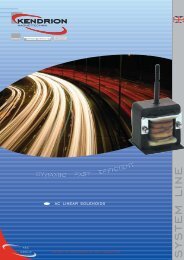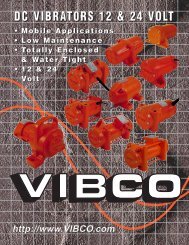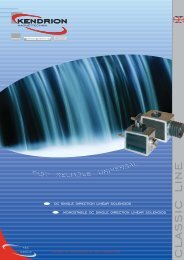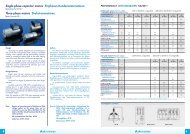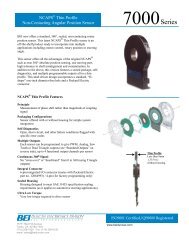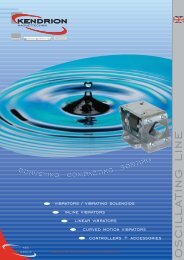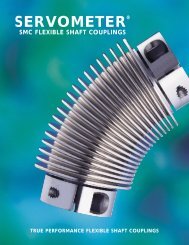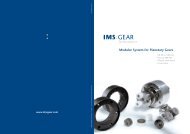External Concrete Vibration - Bertda Services
External Concrete Vibration - Bertda Services
External Concrete Vibration - Bertda Services
- No tags were found...
Create successful ePaper yourself
Turn your PDF publications into a flip-book with our unique Google optimized e-Paper software.
ENGINEERING DATA<br />
& APPLICATIONS<br />
SEPTIC TANKS<br />
BURIAL VAULTS<br />
VIBRATORS MOST COMMONLY USED ON<br />
SEPTIC TANKS & BURIAL VAULTS<br />
PORTABLE & ELECTRIC: Model US-900 & US-1600 high frequency vibrators, up to 10,000 vibrations per minute. Easy<br />
115 volt plug in, low amperage and can be plugged into any light outlet. US-900 is mounted on a wedge bracket model<br />
UW-2 (pages 2-5). The UWF female bracket is welded to the form (see mounting below). The US-1600 is mounted on a<br />
UW-3 wedge. The US-900 is used on standard septic tanks, US-1600 on larger ones.<br />
IMPORTANT NOTE: High Frequency Electric Vibrators are intermittent duty units with a maximum “on” time per hour of 30<br />
minutes. If vibration time extends beyond the duty time, use two units and leapfrog them from form to form.<br />
The wedge brackets transfer vibration up to 90%. For 100% transfer use Model USL-900 & USL 1600 with lug bracket (see<br />
page 6 & 7). For Burial Vaults use Model USP-900 (page 9).<br />
PORTABLE PNEUMATIC: For septic tanks use Model SVRWS-4000 Silent High Frequency Vibrator up to 11,000 VPM<br />
(page 3). This unit is recommended for the larger forms and CCW-2000 (page 3). Silent Pneumatic Vibrator is<br />
recommended for the smaller forms. CCW-2000 is prelubricated for life and the SVRWS-4000 needs to be lubricated from<br />
an oiler in the airline. For burial vaults use VSP-510 silent pneumatic turbine vibrator (see page 9).<br />
PERMANENTLY MOUNTED VIBRATORS: Many concrete producers choose to mount the vibrator permanently on the<br />
forms to save time, lower labor cost, and reduce handling of the equipment and repair costs.<br />
Suggested vibrators for permanent mountings are Electric Model US-900 for standard septic tanks and burial vaults.<br />
US-1600 in single phase or 2P-200 in 3 phase (page 16 & 17) or the pneumatic unit Model CCF-2000 for standard septic<br />
tanks and for the large ones Model SVRFS-4000 (page 14-15). For burial vaults use Model VSP-510 (page 9).<br />
HOW & WHERE TO MOUNT THE VIBRATORS<br />
QUESTION: Why can’t I mount the vibrator to the skin of the form<br />
ANSWER: When you put a vibrator directly on the skin of the form, you create several problems.<br />
1. You create an “oil canning effect.” The movement of the skin actually draws air in, producing air holes.<br />
2. The vibration energy is not distributed over form side but is concentrated just around the vibrator. This concentrated force<br />
will create fatigue cracks in the form skin and the vibration may actually tear out a piece of the form around the<br />
vibrator. The concentrated vibration energy also may cause segregation where the vibrator is mounted.<br />
The correct way to mount the vibrators is on a stiffener to distribute the vibration energy or force over a larger surface as<br />
well as to prevent the “oil canning effect,” reducing the problem of fatigue cracks.<br />
SUGGESTION #1<br />
Acceptable Mount:<br />
Mounting plate<br />
parallel to stiffener<br />
SUGGESTION #2<br />
Preferred Mount:<br />
Channel iron over<br />
stiffeners<br />
VIBRATOR<br />
#2 preferred mount is better because:<br />
1. An added stiffener is usually only tack welded to the skin of the form and if welds are not reinforced fatigue cracks<br />
may develop.<br />
2. If you secure a channel iron over 3 stiffeners as in the preferred #2 mount, you are using stiffeners that are a rigid<br />
part of the form and the energy forces of the vibrator are used much more effectively.<br />
26<br />
PHONE: 800-633-0032 • www.vibco.com • FAX: 401-539-2584



